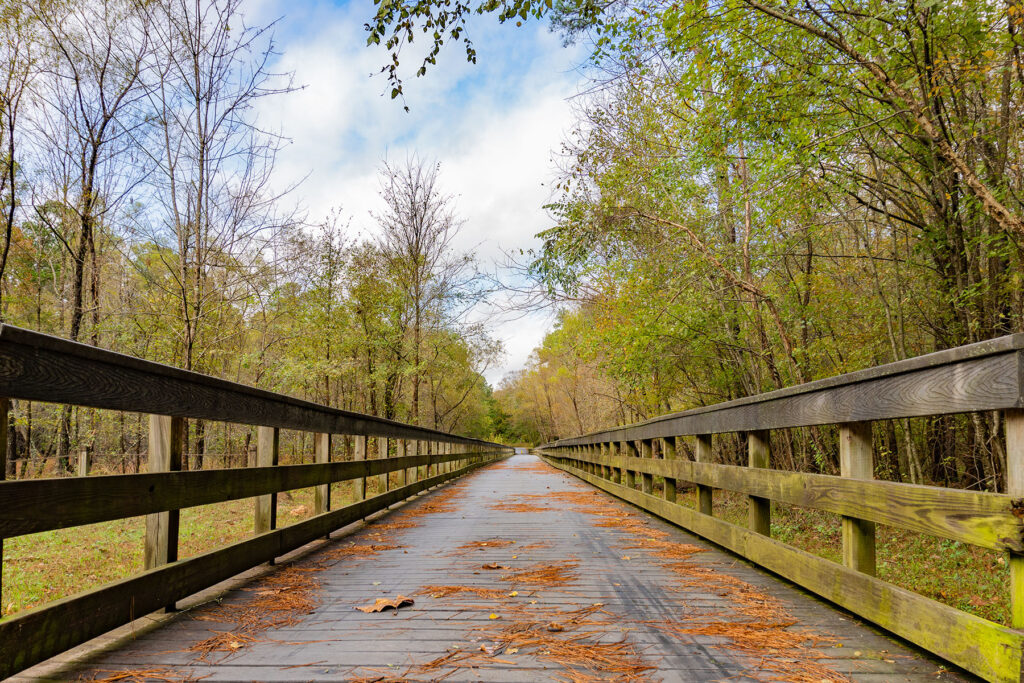Article:
The Neuse: This state treasure originates in Durham and flows into the Pamlico Sound
BY ANITA B. STONE
The Neuse River originates in western Durham County and is one of the country’s oldest rivers, according to the conservation organization American Rivers. It’s a state treasure that belongs solely to North Carolina, since its entire 248-mile length lies within the state’s boundaries.
The Neuse’s headwaters begin in the watershed just above Falls Lake at the confluence of the Flat, Little and Eno rivers. It then enters the Falls Lake reservoir and flows through Wake, Johnston, Wayne, Lenoir, Craven, Pamlico and Carteret counties toward the coast, where it eventually drains with the Trent River into the Pamlico Sound, which is considered the river’s mouth. There, the Neuse is considered the widest river in America at 6 miles across.
The Neuse runs fast near the upper part of the watershed above Falls Lake, but then widens and flows calmly, banked by forests and other vegetation. About 15 miles southeast of Goldsboro in Wayne County is Cliffs of the Neuse State Park, which sits upon 90-foot bluffs overlooking the river. It then slows down and spreads widely through lowland swamps as it flows coastward. With the help of other nearby rivers, the Neuse forms one of the country’s largest estuaries, which is home to many species of wildlife.
The Passage to Protection
The Neuse enhances the natural beauty of North Carolina’s Piedmont as it courses through Raleigh and surrounding areas, and plays an important role in the region’s recreational opportunities and economic expansion. Local citizens, well aware of the Neuse’s charm, enjoy its bounty but may not know of its unique history and struggle to survive.
In 1584, two expeditioners under Sir Walter Raleigh’s direction reported their encounter with the Neusiok, an ancient Native American tribe that had settled along the river. One of the explorers, Arthur Barlowe, wrote that the river was “a goodly river called the Neuse.” For the Neusiok, “neuse” translated to “peace.” The river garnered other names as well. The Tuscarora, for example, referred to it as Gow-ta-no, or “pine in water.”
Today, the Neuse River presents a largely accessible waterway for recreation and relaxation, but its story has not always been a happy one. Over the years, it became heavily polluted from agricultural runoff, industrial waste and increased urbanization. By the 1990s, those pollutants created an environment that encouraged excessive algae blooms, toxic bacterial growth and a reduction in the water’s oxygen that resulted in numerous fish kills along the river.
Among those who came to the river’s aid were the state legislature, adjacent farms, local industry representatives, the Environmental Protection Agency, leaders of many of the Neuse’s riverside cities, and the Riverkeepers, who are charged with monitoring and protecting the Neuse and Tar-Pamlico River watersheds. In conjunction with the federal government’s revised Clean Water Act of 1972, these combined efforts resulted in the Neuse’s rebirth as a healthier waterway. In 2022, the Neuse received the America Rivers’ River of the Year award in honor of those who worked tirelessly to clean it up. The award celebrated the progress of making this “national success story” cleaner and healthier. But it also came with important caveats by calling for cleanup efforts to continue—since the task was not complete—and cautioned that the river’s health would need careful monitoring.
Maintaining Awareness
Rivers are national—but fragile—treasures, since they may seem less permanent or unchanging than a mountain, for example. But these important waterways can be easily overworked or dangerously polluted via careless clearcutting for new developments, and via waste from agricultural and animal operations or careless clearcutting for new developments. Aside from our rivers’ fundamental function of carrying excess water from the land, and their value for supporting wildlife of all sorts, their role in human history is incalculable. They provide drinking water and food, form commercial highways, serve as conduits for removal of human-created wastes, and donate their natural gifts for human appreciation.
Many of the Neuse’s caretakers remain concerned that it faces increasing threats due to agricultural and husbandry practices, destructive storms, flooding and industrial growth along the river’s banks. When combined with the region’s growing population and possible loosening of state and/or federal restrictions, these factors create an environment that could overwhelm the Neuse’s ability to clean itself. Raising awareness of its importance is critical to protecting the drinking water it produces, the wildlife it supports, the state’s economy and our personal enjoyment of this beautiful and ancient river.

The Passage to Protection
In 2023, North Carolina’s legislature enacted the Year of the Trail, a designation bringing attention to the state’s many beautiful nature trails. Some of the trails associated with the Neuse are regular hiking trails, while others feature boardwalks with bridges over rivers and other wet areas. There are even some for paddlers, located entirely on the river.
The Neuse River Trail, a scenic paved greenway stretching from Falls Lake Dam to the Wake County line near Clayton, winds along the river as part of North Carolina’s Mountains-to-Sea trail that extends from the Great Smoky Mountains to the Outer Banks. It is also part of the East Coast Greenway that runs from Maine to Florida. In 2021, Raleigh’s City Council approved the Neuse River Blueway Plan to enhance recreational access to the river with its proposed route passing by the Cliffs of the Neuse, near Goldsboro.
Sources: britannica.com, americanrivers.org, nationalgeographic.org, ncdcr.gov and ncpedia.org.



